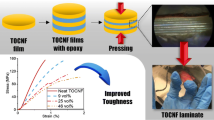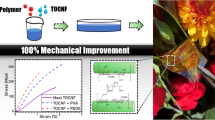Abstract
In this paper, nanofibrillated cellulose/carboxymethyl cellulose (CMC) composite films were prepared using tape casting. The obtained transparent films showed shear induced partial alignment of fibrils along the casting direction, resulting in birefringence in cross polarized light. The carboxyl groups of CMC could be further utilized to create ionic crosslinking by treatment with glycidyl trimethyl ammonium chloride (GTMA). The GTMA treated composite films had improved mechanical properties both in wet and dry state. The chemical composition and morphologies of composites were analyzed with X-ray photoelectron spectroscopy, elemental analysis, scanning electron microscopy and wide-angle X-ray scattering.






Similar content being viewed by others
References
Agoda-Tandjawa G, Durand S, Berot S, Blassel C, Gaillard C, Garnier C, Doublier JL (2010) Rheological characterization of microfibrillated cellulose suspensions after freezing. Carbohydr Polym 80:677–686
Ahola S, Myllytie P, Österberg M, Teerinen T, Laine J (2008) Effect of polymer adsorption on cellulose nanofibril water binding capacity and aggregation. Biores 3(4):1315–1328
Beamson G, Briggs D (1992) High resolution XPS of organic polymers: the Scienta ESCA 300 database. Wiley, Chichester
Beghello L (1998) Some factors that influence fiber flocculation. Nord Pulp Paper Res J 13:272–279
Blomstedt M, Vuorinen T (2007) Modification of softwood kraft pulp with carboxymethyl cellulose and cationic surfactants. J Wood Sci 53:223–228
Cranston ED, Gray DG (2006) Formation of cellulose-based electrostatic layer-by-layer films in a magnetic field. Sci Technol Adv Mater 7:319–321
Csoka L, Hoeger IC, Peralta P, Peszlen I, Rojas OJ (2011) Dielectrophoresis of cellulose nanocrystals and alignment in ultrathin films by electric field-assisted shear assembly. J Coll Int Sci 363:206–212
Ebeling T, Paillet M, Borsali R, Diat O, Dufresne A, Cavaillé JY, Chanzy H (1999) Shear-induced orientation phenomena in suspensions of cellulose microcrystals revealed by small angle X-ray scattering. Langmuir 15(19):6123–6126
Eronen P, Junka K, Laine J, Österberg M (2011) Interaction between water-soluble polysaccharides and native nanofibrillar cellulose thin films. Biores 6:4200–4217
Filpponen I, Kontturi E, Nummelin S, Rosilo H, Kolehmainen E, Ikkala O, Laine J (2012) Generic method for modular surface modification of cellulosic materials in aqueous medium by sequential “click” reaction and adsorption. Biomacromolecules 13:736–742
Gärdlund L, Wågberg L, Gernandt R (2003) Polyelectrolyte complexes for surface modification of wood fibres II. Influence of complexes on wet and dry strength of paper. Colloids Surf 218:137–149
Gedde UW (1995) Polymer Physics. Chapman & Hall, London, UK
Gindl W, Keckes J (2007) Drawing of self-reinforced cellulose films. J Appl Polym Sci 103:2703–2708
Habibi Y, Heim T, Douillard R (2008) AC electric field-assisted assembly and alignment of cellulose nanocrystals. J Polym Sci, Part B: Polym Phys 46(14):1430–1436
Herrick FW, Casebier RL, Hamilton JK, Sandberg KR (1983) Microfibrillated cellulose: morphology and accessibility. J Appl Polym Sci: Appl Polym Symp 37:797–813
Hoeger I, Rojas OJ, Efimenko K, Velev OD, Kelley SS (2011) Ultrathin film coatings of aligned cellulose nanocrystals from a convective-shear assembly system and their surface mechanical properties. Soft Matter 7:1957–1967
Hotza D, Greil P (1995) Review: aqueous tape casting of ceramic powders. Mat Sci Eng A 202:206–217
Hubbe MA (2006) Bonding between cellulosic fibers in the absence and presence of dry-strength agents—a review. BioResources 1(2):281–318
Johansson LS, Campbell J (2004) Reproducible XPS on biopolymers: cellulose studies. Surf Interface Anal 36:1018–1022
Johansson LS, Tammelin T, Campbell JM, Setälä H, Österberg M (2011) Experimental evidence on medium driven cellulose surface adaptation demonstrated using nanofibrillated cellulose. Soft Matter 7:10917–10924
Karppinen A, Saarinen T, Salmela J, Laukkanen A, Nuopponen M, Seppälä J (2012) Flocculation of microfibrillated cellulose in shear flow. Cellulose. doi:10.1007/s10570-012-9766-5
Kimura F, Kimura T, Tamura M, Hirai A, Ikuno M, Horii F (2005) Magnetic alignment of the chiral nematic phase of a cellulose microfibril suspension. Langmuir 21:2034–2037
Korkut S, Roy-Mayhew JD, Dabbs DM, Milius DL, Aksay IA (2011) High surface area tapes produced with functionalized graphene. ACS Nano 5(6):5214–5222
Kvien I, Oksman K (2007) Orientation of cellulose nanowhiskers in polyvinyl alcohol. Appl Phys A 87:641–643
Laine J, Lindström T, Nordmark GG, Risinger G (2000) Studies on topochemical modification of cellulosic fibers. Part 1. Chemical conditions for the attachment of carboxymethyl cellulose onto fibers. Nord Pulp Paper Res J 15(5):520–526
Lanticse LJ, Tanabe Y, Matsui K, Kaburagi Y, Suda K, Hoteida M, Endo M, Yasuda E (2006) Shear induced preferential alignment of carbon nanotubes resulted in anisotropic electrical conductivity of polymer composites. Carbon 44:3078–3086
Lasseuguette E, Roux D, Nishiyama Y (2008) Rheological properties of microfibrillar suspension of TEMPO-oxidized pulp. Cellulose 15:425–433
Libanori R, Münch FHL, Montenegro DM, Studart A (2012) Hierarchical reinforcement of polyurethane-based composites with inorganic micro- and nanoplatelets. Comp Sci Tech 72:435–445
Liu Z, Choi H, Gatenholm P, Esker AR (2011) Quartz crystal microbalance with dissipation monitoring and surface plasmon resonance studies of carboxymethyl cellulose adsorption onto regenerated cellulose surfaces. Langmuir 27:8718–8728
Orelma H, Teerinen T, Johansson LS, Holappa S, Laine J (2012a) CMC-modified cellulose biointerface for antibody conjugation. Biomacromolecules 13:1051–1058
Orelma H, Filpponen I, Johansson LS, Österberg M, Rojas OJ, Laine J (2012b) Surface functionalized nanofibrillar cellulose (NFC) film as a platform for rapid immunoassays and diagnostics. Biointerphases 7:61
Orts WJ, Godbout L, Marchessault RH, Revol JF (1998) Enhanced ordering of liquid crystalline suspensions of cellulose microfibrils: a small angle neutron scattering study. Macromolecules 31:5717–5725
Pääkkö M, Ankerfors M, Kosonen H, Nykänen A, Ahola S, Österberg M, Ruokolainen J, Laine J, Larsson PT, Ikkala O, Lindström T (2007) Enzymatic hydrolysis combined with mechanical shearing and high-pressure homogenization for nanoscale cellulose fibrils and strong gels. Biomacromolecules 8:1934–1941
Plackett D, Siró I (2010) Microfibrillated cellulose and new nanocomposite materials: a review. Cellulose 17:459–494
Pullawan T, Wilkinson AN, Eichhorn SJ (2012) Influence of magnetic field alignment of cellulose whiskers on the mechanics of all-cellulose nanocomposites. Biomacromolecules 13:2528–2536
Saarikoski E, Saarinen T, Salmela J, Seppälä J (2012) Flocculated flow of microfibrillated cellulose water suspensions: an imaging approach for characterization of rheological behavior. Cellulose 19(3):647–659
Saito T, Nishiyama Y, Putaux J, Vignon M, Isogai A (2006) Homogeneous suspensions of individualized microfibrils from TEMPO-catalyzed oxidation of native cellulose. Biomacromolecules 7:1687–1691
Sehaqui H, Mushi NE, Morimune S, Salajkova M, Nishino T, Berglund LA (2012) Cellulose nanofiber orientation in nanopaper and nanocomposites by cold drawing. Appl Mater Interface 4:1043–1049
Tiitu M, Laine J, Serimaa R, Ikkala O (2006) Ionically self-assembled carboxymethyl cellulose/surfactant complexes for antistatic paper coatings. J Coll Int Sci 301:92–97
Turbak AF, Snyder FW, Sandberg KR (1983) Microfibrilated cellulose, a new cellulose product: properties, uses, and commercial potential. J Appl Polym Sci: Appl Polym Symp 37:815–827
Uddin A, Araki J, Gotoh Y (2011) Toward strong green nanocomposites: polyvinyl alcohol reinforced with extremely oriented cellulose whiskers. Biomacromolecules 12:617–624
Uschanov P, Johansson LS, Maunu SL, Laine J (2010) Heterogeneous modification of various celluloses with fatty acids. Cellulose 18:393–404
Van Opdenbosch D, Maisch P, Flitz-Popovski G, Paris O, Zollfrank C (2012) Transparent cellulose sheets as synthesis matrices for inorganic functional particles. Carbohydr Polym 87:257–264
Xhanari K, Syverud K, Chinga-Carrasco G, Paso K, Stenius P (2011) Reduction of water wettability of nanofibrillated cellulose by adsorption of cationic surfactants. Cellulose 18:257–270
Yan H, Lindström T, Christiernin M (2006) Some ways to decrease fibre suspension flocculation and improve sheet formation. Nord Pulp Paper Res J 21:36–43
Yoshiharu N, Shigenori K, Masahisa W, Takeshi O (1997) Cellulose microcrystal film of high uniaxial orientation. Macromolecules 30:6395–6397
Zauscher S, Klingenberg J (2001) Friction between cellulose surfaces measured with colloidal probe microscopy. Colloids Surf A 178(1–3):213–229
Acknowledgments
This work has been funded by the Graduate School for Biomass Refining (Academy of Finland) and the Finnish Funding Agency for Technology and Innovation (project “Tailoring of nanocellulose structures for industrial applications” NASEVA 2). We gratefully acknowledge Dr. Joseph Campbell for his contribution to the XPS measurements. UPM-Kymmene Corporation is acknowledged for supplying the UPM Fibril Cellulose raw material. This work made use of Aalto University Nanomicroscopy Center (Aalto-NMC) facilities.
Author information
Authors and Affiliations
Corresponding author
Rights and permissions
About this article
Cite this article
Pahimanolis, N., Salminen, A., Penttilä, P.A. et al. Nanofibrillated cellulose/carboxymethyl cellulose composite with improved wet strength. Cellulose 20, 1459–1468 (2013). https://doi.org/10.1007/s10570-013-9923-5
Received:
Accepted:
Published:
Issue Date:
DOI: https://doi.org/10.1007/s10570-013-9923-5




